Growing sorrel is the perfect addition to your herb garden if you’re looking to expand your leafy green vegetables. Its unique, lemony flavor is delicious in salads and various dishes. Best of all, it’s super easy to grow and maintain. In this article I’m going to walk through how to grow sorrel. I’ll break it down step-by-step so you can enjoy an abundance of this lovely herb.
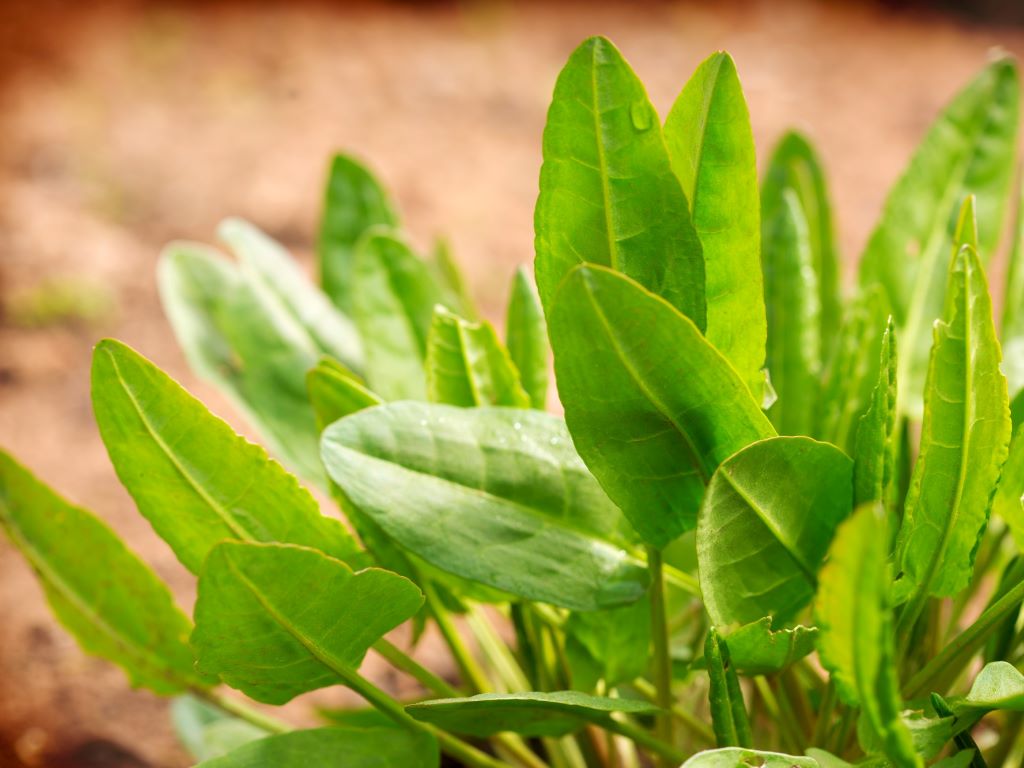
You can expect to enjoy a bountiful harvest of sorrel in around 70 days. So, let’s jump right in and explore some of the reasons to grow sorrel!
- It is a rich source of nutrients like vitamin C, manganese, and iron. Incorporating sorrel into your diet can help boost your immune system, support bone health, and improve your digestive system.
- The tangy, lemony flavor of sorrel is an excellent addition to fresh salads. Or you can cook it like spinach to add a unique twist to your recipes. Sorrel is also used in soups, stews, and sauces.
- Sorrel is a fantastic companion plant in your garden. It’s known to attract beneficial insects like hoverflies, which help control aphids. And because it is low growing, it serves as a natural mulch, helping to retain moisture and suppress weeds around your other plants.
- It can grow in light shade and is perfect to mix with other shade loving herbs, especially in warmer climates.
Another benefit of growing sorrel is that it is a hardy perennial plant in USDA Zones 5-9. A low-maintenance plant, it can thrive in a wide range of environments and grow back year after year.
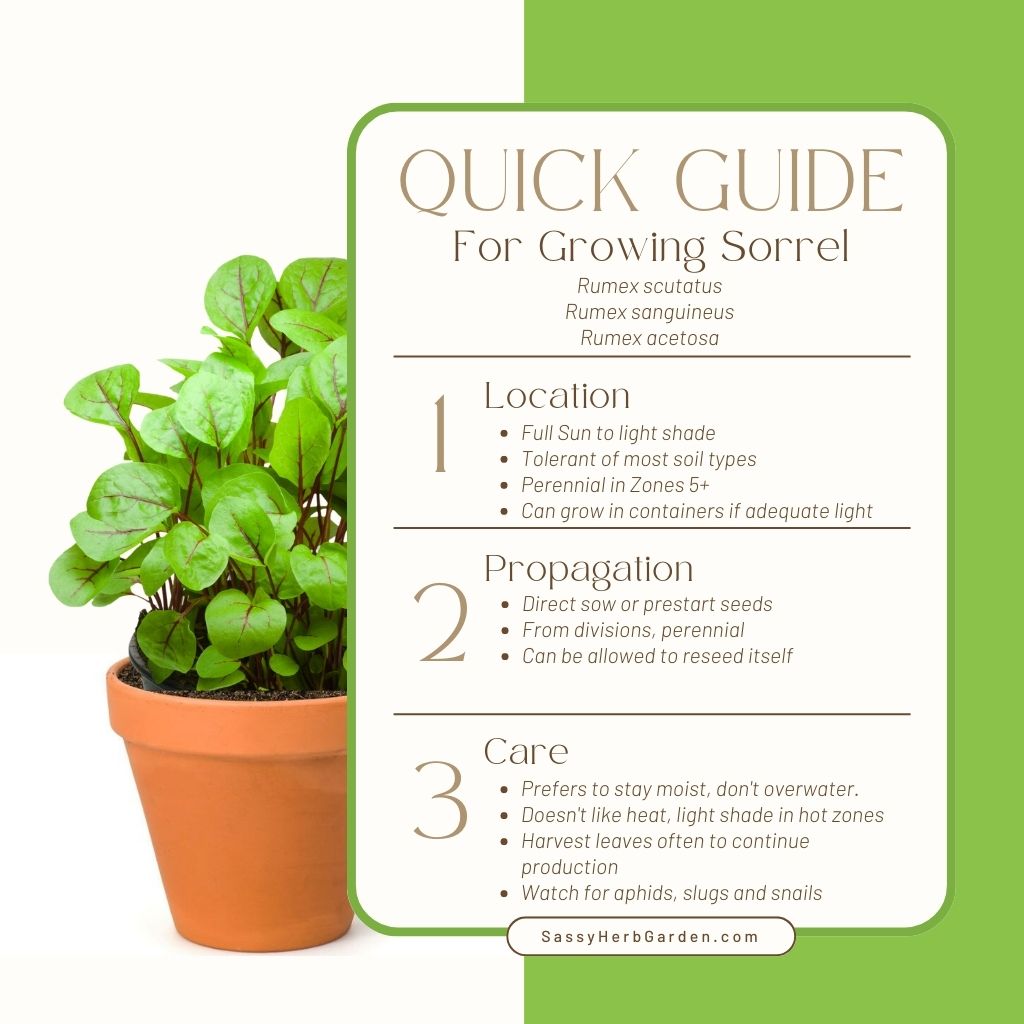
Types of Sorrel
There are various types of sorrel that can be grown in your herb garden. Each vary in taste and appearance. In this section, we’ll explore three popular varieties: French Sorrel, Garden Sorrel, and Red-Veined Sorrel.
French Sorrel (Rumex Scutatus)
French sorrel is a popular variety among gardeners. This type of sorrel is characterized by its small, shield-shaped leaves. It has a milder, less acidic flavor than other varieties. French sorrel is an excellent choice in salads, soups, or sauces.
Garden Sorrel (Rumex Acetosa)
Garden sorrel is another popular variety widely grown in home gardens. It features larger, more elongated leaves with a pronounced lemony tang. Garden sorrel leaves are rich in vitamin A, vitamin C, and potassium.
Red-Veined Sorrel (Rumex sanguineus)
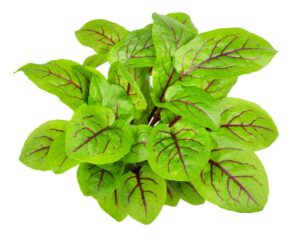
Red-veined sorrel is often used for its colorful addition to salads. The leaves are bright green with vibrant red veins. While the flavor is similar to that of garden sorrel, red-veined sorrel has a slightly milder taste.
Because of the compact nature of sorrel, you can easily grow all three varieties and enjoy the flavors in your kitchen.
How to Grow Sorrel from Seed
Let’s walk through selecting sorrel seeds, sowing seeds indoors, and planting seedlings in the garden.
Selecting Sorrel Seeds
When choosing sorrel seeds, remember that there are different varieties of sorrel with unique flavors and heights. Many nurseries will simply label them as “sorrel,” but if possible, try to identify the specific variety when purchasing seeds or established plants.
Sowing Seeds Indoors: Step-by-Step
Start Sorrel seeds 3 to 4 weeks before the last frost in the spring. You may want to start a second crop about 2 weeks later to extend the length of your harvest.
- Prepare the soil: Use a seed starting mix or good-quality potting soil, lightly moistened but not wet. Fill your seed trays or pots with the soil.
- Sow the sorrel seeds: Plant the seeds 1/4 inch deep, spacing them about 2 inches apart. Gently press them into the soil and cover them with a thin layer of soil.
- Provide light and warmth: Place the trays or pots in a warm location, preferably around 65-75°F. If possible, use a grow light or place near a south-facing window to provide plenty of sunlight.
- Water and monitor: Keep the soil moist but not soggy. Use a fine mist spray bottle or a gentle watering can to prevent the seeds from being disturbed. Germination should occur within 7-14 days.
If you want to continue to pick sorrel all summer, planting subsequent rows of seed directly into the garden is easy. When planting sorrel direct from seeds, wait until the last frost has passed, and the soil temperature has reached at least 50°F (10°C). Sow the seeds at a depth of about 1/4 inch, with 2-3 seeds per clump. Space the clumps 12-18 inches apart.
Planting Seedlings in the Garden
After the risk of frost has passed, you can move your sorrel plants outside.
- Harden off the seedlings: Once your sorrel seedlings have developed 2-3 true leaves, gradually expose them to outdoor conditions. Start with a couple of hours a day on a shaded spot and increase the exposure duration daily, for about a week.
- Prepare the garden bed: Choose a spot in your garden with full sun to light shade. In hot climates, sorrel will benefit from a little shade to keep from overheating. Loosen the soil to a depth of about 12 inches, and mix well with organic matter.
- Transplant the seedlings: Plant the seedlings 1 foot apart to allow for growth. Carefully remove them from their trays or pots, ensuring not to damage the roots. Dig a hole deep enough for the root ball, place the seedling in the hole, and gently backfill with soil
- Transplant the seedlings: Plant the seedlings 1 foot apart to allow for growth. Carefully remove them from their trays or pots, ensuring not to damage the roots. Dig a hole deep enough for the root ball, place the seedling in the hole, and gently backfill with soil.
Other Ways to Propagate Sorrel
Sorrel is a Perennial
In zones 5-9, sorrel will return every year. In colder climates the roots usually will freeze out and need to be replanted. When growing as a perennial, divide the root balls every 2 to 3 years to keep the leaf growth young and tender. Older plants tend to be a bit bitter.
While sorrel is not a happy perennial in hotter climates (zones 10 plus), it does easily re-seed itself. So if you let the last crop of the season go to seed, it will often start to emerge as the ground warms up in early spring.
Caring for Sorrel
Growing sorrel is easy because it is a very adaptable plant. I’ll share the ideal conditions, but seriously if you mess up your sorrel will likely grow prolifically anyway. So don’t stress about growing sorrel in your garden.
Watering and Fertilizing
Generally, you should water sorrel plants deeply and consistently, especially during the growing season. Make sure the soil remains moist but not soggy, as overwatering can lead to root rot and will attract slugs.
Sorrel is not a heavy feeder but benefits from a balanced, all-purpose fertilizer to support steady growth. Apply a slow-release fertilizer or compost at the beginning of the growing season, and reapply every 4-6 weeks during peak growth. Be careful not to over-fertilize, as this could lead to excessive foliage growth and reduced flavor in the leaves.
Pruning
Pruning your sorrel plants will not only encourage bushier growth but also prevent the plants from becoming too leggy or untidy. Regularly remove any dead, yellowing, or damaged leaves to promote better air circulation and overall plant health.
One essential aspect growing healthy sorrel is to be diligent about removing flowering stalks. When sorrel plants start to bolt, or produce flowers, their leaves may turn bitter. Cut off flower stalks as soon as they appear to prolong the harvest and maintain the desirable tangy flavor of the sorrel leaves.
Growing Sorrel in a Pot
Growing sorrel in a pot is easy and with proper care, you can enjoy fresh, tangy sorrel even if you live in an apartment or have limited space. In this section, we will cover the essentials of growing sorrel in containers, focusing on selecting the right soil and pot, and proper care when growing indoors.
Selecting Soil and Pot
To grow sorrel successfully in a pot, choose a container that is at least 12 inches in diameter and has adequate drainage holes. This will allow the roots to spread and prevent waterlogging, promoting overall plant health.
For the soil, use a well-draining organic potting mix. Sorrel grows best with a soil pH of 6.0 to 6.8, which is slightly acidic. You can test the pH using a soil testing kit and adjust it by adding peat moss or limestone as needed. Make sure to keep the soil moist but not soggy throughout the growing process.
Care when Growing Sorrel Indoors
When growing sorrel indoors place your pot in a sunny spot, ideally near a south-facing window where it can receive at least 6 hours of direct sunlight daily. Sorrel can also thrive in partial or dappled shade, so don’t worry if you don’t have a perfect spot.
Sow the sorrel seeds about ½ inch deep and space them 3 inches apart. Keep the soil consistently moist by watering regularly, but avoid overwatering. As soon as the seedlings develop two sets of true leaves, thin them to 12 inches apart. You can use the thinned seedlings in a salad or transplant them to another pot.
Sorrel is a cool-season crop, so it does well in a cooler window. That makes it a great herb to continue to grow all winter in a kitchen garden. My green-house window is ideal because it is on the cool side once the temperatures drop in the fall.
Remember to fertilize your potted sorrel every 4 to 6 weeks using a balanced liquid fertilizer, diluted to half strength. This will ensure that your sorrel receives the necessary nutrients for healthy growth and production. The more often you harvest, the more sorrel will produce new leaves so enjoy your potted herb often.
Common Problems and Solutions
Growing sorrel can be a delightful addition to your garden, but like all plants, it may encounter some common problems. Let’s discuss solutions to tackle pests and diseases that might be affecting your sorrel plants.
Common Pests
Slugs and Snails are the most common problem on sorrel growing in your garden beds. They love the soft fleshy leaves and can cause quite a bit of damage. According to the University of Iowa extension your best defense in slug control is two part:
- Remove moist hiding places: boards, leaves, debris, rotting leaves.
- Use an attractant or bait to lure slugs away from your plants. These can be natural like beer dishes or chemical slug baits. Because these pests are mollusks, there are many baits that are safe for your garden and your pets like the Garden Safe Snail and Slug Bait.
You’ll often see advice to just pick off snails and slugs to control but since they feed at night that is often not a reasonable solution.
Aphids, thrips and spider mites may appear on he leaves, causing them to yellow and wilt. While not usually a problem, if you do get an infestation you’ll want to hop on it and get these pests under control:
- Use insecticidal soap or neem oil to treat your plants if you notice a significant number of pests. It will take several applications to break the life cycle of these little bugs so don’t stop with just one spray. Spray at least 3 times, 3-4 days apart.
- Introduce beneficial insects like ladybugs or lacewings, which feed on many common garden pests.
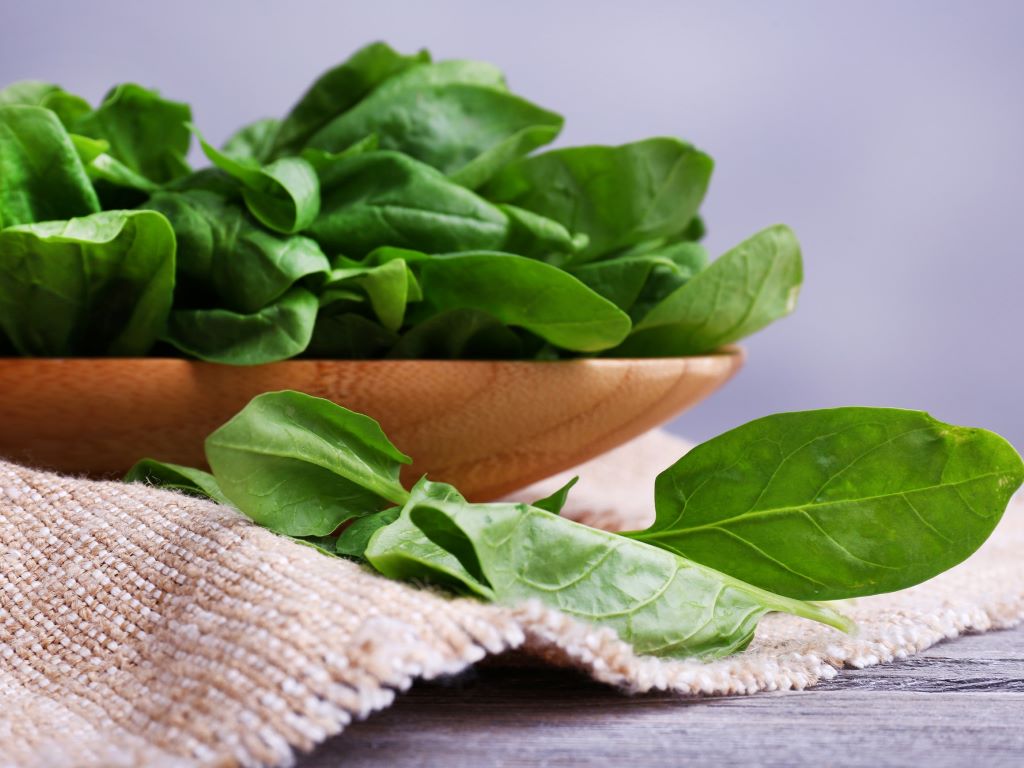
Harvesting and Storing Sorrel
When to Harvest
Sorrel can be harvested once the leaves are about 3-4 inches long. You can harvest sorrel leaves as needed throughout the season. As a cool season crop, you can usually continue to harvest until there is a hard freeze in the garden. Continually picking the leaves encourages new growth, which means more fresh sorrel for your culinary creations.
Methods of Harvesting
To harvest the sorrel leaves you are growing, simply cut them off near the base of the plant. Be careful not to damage the roots, as this can negatively impact the plant’s overall health. Use a clean, sharp pair of scissors or garden shears to ensure a clean cut. Since sorrel grows close to the ground it tends to be a dirty herb so the leaves require a good wash before using.
Cut-and-Come-Again Technique
The cut-and-come-again technique is a popular method for harvesting sorrel leaves, as it encourages the plant to continually produce fresh leaves. To do this, simply harvest the outer leaves of the plant, allowing the inner leaves to keep growing. This method ensures that the plant continues to produce fresh, tender leaves throughout the growing season. By regularly harvesting the outer leaves, you can enjoy a steady supply of sorrel for your culinary creations in the garden and the kitchen.
Extend your Harvest with Staggered Planting
Just as you would when growing lettuces and other cool season plants, you can stagger plant. Just plant additional sorrel seeds every 2-3 weeks to keep a good supply of the young tender leaves all summer.
Drying Sorrel
While most sorrel is used in it’s fresh state for salads and culinary delights, there are several uses for dried sorrel. It’s a highly nutritious plant that can be used in teas, smoothies, and a few Jamaican and African recipes.
Sorrel preserves best when air dried or processed in a dehydrator. The leaves contain an abundance of moisture so it takes longer to dry than most herbs. Be patient to ensure the leaves are completely dry before storing. If there is any moisture left, the sorrel will mold in storage.
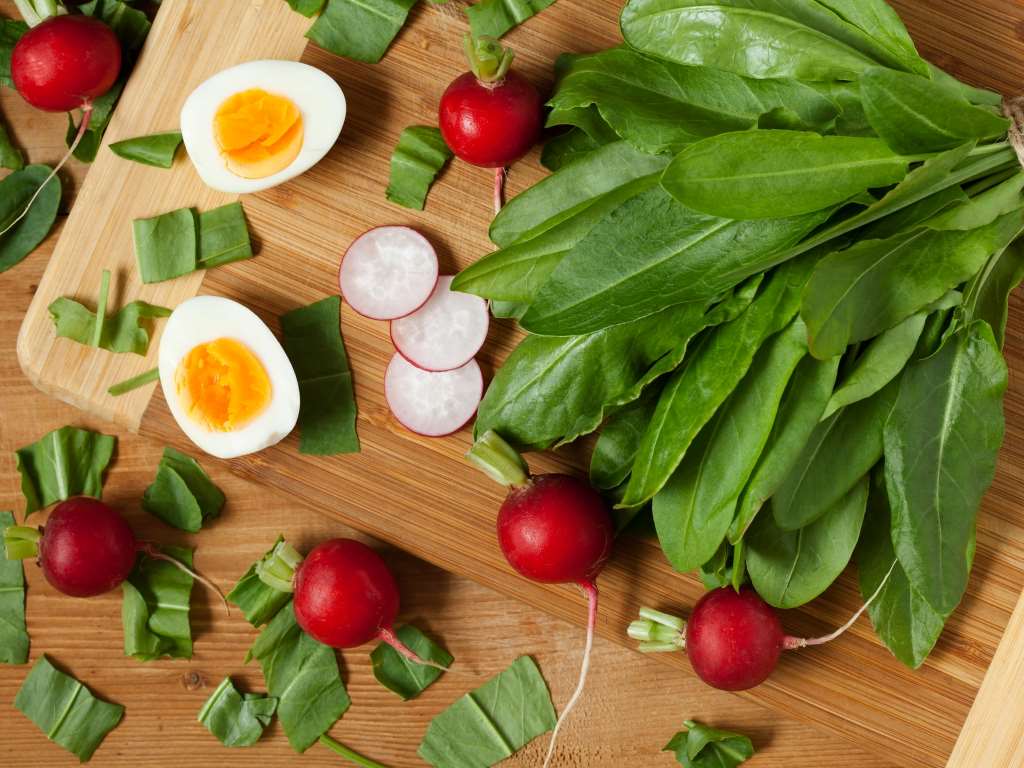
Culinary Uses of Sorrel
Sorrel’s pleasant tart, lemon flavor lends well to a variety of dishes. The simple salad is a great place to start, but don’t stop there. If you’d like to take your culinary exploration up a notch I found this mouthwatering article on cooking with sorrel from the NY Times.
Perfect for Salads and Soups
Incorporating sorrel into your salads adds a delightful, tangy twist to your lunch. Young leaves are ideal for salads as they have a milder flavor. Simply mix the sorrel leaves with leafy greens, such as spinach or lettuce, and your favorite salad ingredients.
If you’re looking for a heartier option, try making a delicious sorrel soup. Use mature leaves in your soup for a stronger lemony flavor. Just like other leafy greens, sorrel can be cooked and its flavor pairs well with other vegetables. You’ll find delicious recipes for sorrel with potatoes and carrots. It also works well in egg dishes and stews.
Sorrel Makes Delicious Sauces
Sorrel can be used to create interesting and flavorful sauces. Cook sorrel with some butter or olive oil then add to a cream sauce for a yummy sauce for chicken or fish. Or mix it with other herbs like basil and parsley to create a unique pesto.
Sorrel Teas
People often enjoy sorrel tea because of its lemony flavor and potential health benefits. To make the tea, steep some fresh or dried sorrel leaves in hot water for a few minutes, strain, and enjoy. You can even add a sweetener if you prefer.
With its diverse culinary applications, sorrel is a wonderful addition to your garden and your kitchen. So go ahead and enjoy experimenting with this versatile and flavorful herb. Happy growing and cooking!
Frequently Asked Questions about How to Grow Sorrel
The best time to plant sorrel seeds is in early spring 3 to 4 weeks before the last frost. It can be planted outside when the soil temperatures have warmed up to around 50°F (10°C).
Choose a location for your sorrel plants that receives full sun or partial shade. Sorrel prefers well-draining soil that’s rich in organic matter.
There are two main types of sorrel used in cooking: Rumex acetosa (garden sorrel) and Rumex scutatus (French sorrel). Garden sorrel has larger, more arrow-shaped leaves with a stronger lemony flavor. French sorrel has smaller, shield-shaped leaves with a more delicate taste. Both are easy to grow and can be used interchangeably in recipes.
Sorrel grows to a height of 12 to 18 inches (30 to 45 cm) with a similar spread. The plants tend to grow in a rosette, with leaves arranged in a circular pattern around the central stem.
Yes, sorrel is a perennial plant, meaning it will return year after year. It will die back during the winter months but will regrow from the same root system in the following spring.
As you can see, learning how to grow sorrel is well worth a little bit of your time. With its easy-to-grow nature and low maintenance requirements, sorrel is a great addition to any herb garden. By following the tips and tricks outlined in this article, you can successfully grow sorrel in your own garden and enjoy its delicious flavor all season long. So go ahead and give it a try – your taste buds will thank you!

